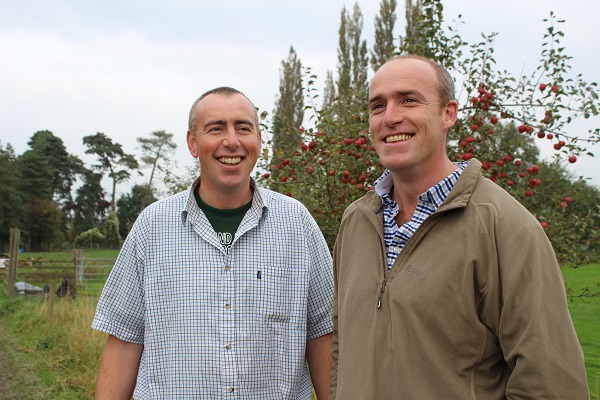Finalists in the 2017 NMR/RABDF Gold Cup competition have been announced and include two block calving grassland-based herds, two high-production Holstein herds, a Channel Island herd and a grass-based block calving herd milked once-a-day. This line up reflects the competition’s new remit, which includes entries from the wider range of management systems and businesses that better reflect today’s UK dairy sector.
The 2017 Gold Cup finalists are:
Thomas Dickinson, Scaftworth, South Yorkshire
Thomas, with parents John and Susan, runs the 270-cow Thurlstone Jersey herd supplying milk to Longley. A small amount is also sold locally through a milk vending machine. Cows on this 163-hectare unit calve in spring and autumn and yield 5,675kg of milk at 5.6% fat and 4.0% protein. Around 60% of milk is produced from home-grown forage – mainly grazed grass with grass and maize silage fed in a TMR. Suitable land and limited cubicle housing mean that a proportion of the herd grazes year-round.
David Williams, Northop, Mold, Clwyd
With his wife, daughter and sister-in-law, David manages a spring calving herd of 275 cross-bred Friesian Jersey cows, plus 171 followers, producing 3,850kg of milk and 350kg of milk solids on once-a-day milking.
They graze as much grass as possible to help minimise silage requirements. And by measuring and planning grazing carefully the family are set to increase stocking rates and take cow numbers up to 300 next year, without increasing costs. The target is to utilise 85% of grass grown, which in 2016 was 13 tonnes of dry matter per hectare.
Chris and Rich Norman, Pembridge, Herefordshire
Chris and Rich Norman have developed a 600-cow dairy along with a 200,000 bird broiler unit and an anaerobic digester on their 162-hectare family farm. Attention to detail, with an emphasis on staff training, means that the team is well equipped to achieve the best from the Friesian Jersey crossbreds on an autumn block calving and paddock grazing system. Average milk yields of 5,536kg, at 4.99% fat and 3.70% protein, are combined with a cell count of 97,000cells/ml and a calving interval of 374 days.
Darren and Stuart McMurran, Banbridge, Northern Ireland
Brothers Darren and Stuart have increased cow numbers to 400 in 2017 and built a new shed with sand-bedded cubicles to house an extra 150 cows. A high yielding herd, cows average 11,751kg of milk, at 3.81% fat and 3.13% protein, on three-times-a-day milking. An all-year-round calving herd, the aim is to average 40 litres a day from 400 cows to maximise output per cubicle, on a unit where land is at a premium.
James Tomlinson, Bilsborrow, Lancashire
James runs the pedigree Bilsrow 260-cow Holstein herd with parents David and Sheila and his wife Eleanor. Current average yield is 11,386kg, at 4.27% fat and 3.126% protein, on twice-a-day milking. They also sell 50 heifers a year and 25 stock bulls. Breeding focuses on health, fertility and lifespan traits and production. Management aims to maximise the potential of the genetics in a natural way that enhances herd longevity, while providing milk and young stock that meets their customers’ requirements.
Andrew Giles, Glasbury on Wye, Herefordshire
Andrew and Rachel Giles, and their young team of three, run a spring calving herd of 550 cross-bred Friesian cows and 275 young stock. A unit dedicated to dairying, the herd’s average yield is 5,316kg of milk at 4.45% fat and 3.5% protein. Cost control and being technically good are the key factors here, with careful soil management and religious monitoring of grass growth. Equally important is breeding the type of cow that can perform well on this system.
The judges – RABDF chairman and south Gloucestershire-based producer Mike King, NMR’s Jonathan Davies, Alvis Bros’ Nick Green, and Leicestershire-based producer and dairy consultant Gaynor Wellwood – will select a winner following their on-farm inspection.
“We are looking at the whole dairy business and at how each unit takes advantages of the farm’s resources,” says Mike King. “How they integrate technical, business and people management skills is important, as well as their contribution to environmental management of the farm and their involvement in the local community. These are factors that apply to all progressive dairy units, regardless of the system.”
The winner and runner up will be announced at the RABDF’s Dairy-Tech event, at Stoneleigh Park on February 7, 2018.
Routes to entry have changed for the 2017 Gold Cup. As well as entries from herds with official milk records that met specific criteria for milk production, somatic cell count and genetic merit, the spring calving index, that also appears on the herd’s milk records, was considered if applicable.
In addition, herds could be nominated for entry to the Gold Cup by regional and national discussion group leaders and specialised grazing groups. These herds did not have to have official milk records, but were expected to have recording protocols in place.






